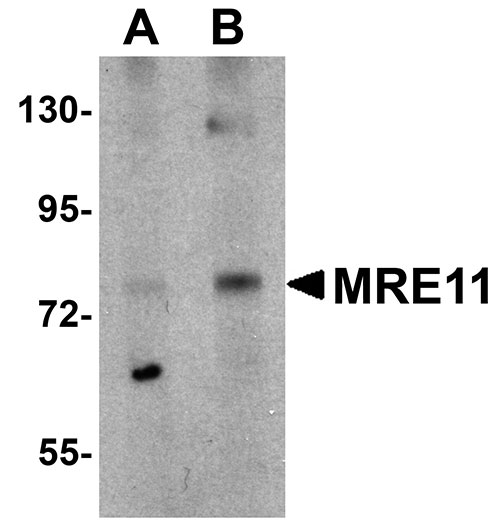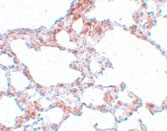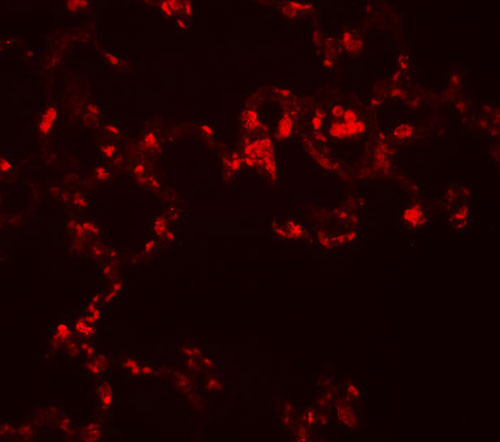MRE11 Antibody
- 产品详情
- 实验流程
- 背景知识
Application
| WB, IF, E, IHC-P |
|---|---|
| Primary Accession | P49959 |
| Other Accession | EAW66932, 119587336 |
| Reactivity | Human, Mouse, Rat |
| Host | Rabbit |
| Clonality | Polyclonal |
| Isotype | IgG |
| Calculated MW | 80593 Da |
| Concentration (mg/ml) | 1 mg/mL |
| Conjugate | Unconjugated |
| Application Notes | MRE11 antibody can be used for detection of MRE11 by Western blot at 1 - 2 µg/mL. Antibody can also be used for immunohistochemistry starting at 5 µg/mL. For immunofluorescence start at 20 µg/mL. |
| Gene ID | 4361 |
|---|---|
| Other Names | Double-strand break repair protein MRE11A, Meiotic recombination 11 homolog 1, MRE11 homolog 1, Meiotic recombination 11 homolog A, MRE11 homolog A, MRE11A, HNGS1, MRE11 |
| Target/Specificity | MRE11A; |
| Reconstitution & Storage | MRE11 antibody can be stored at 4℃ for three months and -20℃, stable for up to one year. As with all antibodies care should be taken to avoid repeated freeze thaw cycles. Antibodies should not be exposed to prolonged high temperatures. |
| Precautions | MRE11 Antibody is for research use only and not for use in diagnostic or therapeutic procedures. |
| Name | MRE11 {ECO:0000303|PubMed:8530104, ECO:0000312|HGNC:HGNC:7230} |
|---|---|
| Function | Core component of the MRN complex, which plays a central role in double-strand break (DSB) repair, DNA recombination, maintenance of telomere integrity and meiosis (PubMed:11741547, PubMed:14657032, PubMed:22078559, PubMed:23080121, PubMed:24316220, PubMed:26240375, PubMed:27889449, PubMed:28867292, PubMed:29670289, PubMed:30464262, PubMed:30612738, PubMed:31353207, PubMed:37696958, PubMed:38128537, PubMed:9590181, PubMed:9651580, PubMed:9705271). The MRN complex is involved in the repair of DNA double-strand breaks (DSBs) via homologous recombination (HR), an error-free mechanism which primarily occurs during S and G2 phases (PubMed:24316220, PubMed:28867292, PubMed:31353207, PubMed:38128537). The complex (1) mediates the end resection of damaged DNA, which generates proper single-stranded DNA, a key initial steps in HR, and is (2) required for the recruitment of other repair factors and efficient activation of ATM and ATR upon DNA damage (PubMed:24316220, PubMed:27889449, PubMed:28867292, PubMed:36050397, PubMed:38128537). Within the MRN complex, MRE11 possesses both single-strand endonuclease activity and double-strand- specific 3'-5' exonuclease activity (PubMed:11741547, PubMed:22078559, PubMed:24316220, PubMed:26240375, PubMed:27889449, PubMed:29670289, PubMed:31353207, PubMed:36563124, PubMed:9590181, PubMed:9651580, PubMed:9705271). After DSBs, MRE11 is loaded onto DSBs sites and cleaves DNA by cooperating with RBBP8/CtIP to initiate end resection (PubMed:27814491, PubMed:27889449, PubMed:30787182). MRE11 first endonucleolytically cleaves the 5' strand at DNA DSB ends to prevent non-homologous end joining (NHEJ) and licence HR (PubMed:24316220). It then generates a single-stranded DNA gap via 3' to 5' exonucleolytic degradation to create entry sites for EXO1- and DNA2-mediated 5' to 3' long-range resection, which is required for single-strand invasion and recombination (PubMed:24316220, PubMed:28867292). RBBP8/CtIP specifically promotes the endonuclease activity of MRE11 to clear protein-DNA adducts and generate clean double-strand break ends (PubMed:27814491, PubMed:27889449, PubMed:30787182). MRE11 endonuclease activity is also enhanced by AGER/RAGE (By similarity). The MRN complex is also required for DNA damage signaling via activation of the ATM and ATR kinases: the nuclease activity of MRE11 is not required to activate ATM and ATR (PubMed:14657032, PubMed:15064416, PubMed:15790808, PubMed:16622404). The MRN complex is also required for the processing of R-loops (PubMed:31537797). The MRN complex is involved in the activation of the cGAS-STING pathway induced by DNA damage during tumorigenesis: the MRN complex acts by displacing CGAS from nucleosome sequestration, thereby activating it (By similarity). In telomeres the MRN complex may modulate t-loop formation (PubMed:10888888). |
| Cellular Location | Nucleus. Chromosome. Chromosome, telomere Note=Localizes to DNA double-strand breaks (DSBs) |
For Research Use Only. Not For Use In Diagnostic Procedures.
Provided below are standard protocols that you may find useful for product applications.
BACKGROUND
MRE11 Antibody: MRE11 is involved in the repair of DNA double strand breaks as part of a complex that includes the Rad50 and NBS1 protein and is thought to act in the same pathway as the A-T mutated (ATM) protein. By itself, the protein has 3' to 5' exonuclease activity and endonuclease activity. The protein forms a complex with the RAD50 homolog; this complex is required for non-homologous joining of DNA ends and possesses increased single-stranded DNA endonuclease and 3' to 5' exonuclease activities. In conjunction with a DNA ligase, this protein promotes the joining of noncomplementary ends in vitro using short homologies near the ends of the DNA fragments. Mutations in this protein result in a novel ataxia telangiectasia-like disorder (ATLD). Unlike the ATM protein, MRE11 is necessary proper mammalian development.
REFERENCES
Stewart GS, Maser RS, Stankovic T, et al. The DNA double-strand break repair gene hMRE11 is mutated in individuals with an ataxia telangiectasia-like disorder. Cell1999; 99:577-87.
Buis J, Wu Y, Deng Y, et al. Mre11 nuclease activity has essential roles in DNA repair and genomic stability distinct from ATM activation. Cell2008; 135:85-96.
终于等到您。ABCEPTA(百远生物)抗体产品。
点击下方“我要评价 ”按钮提交您的反馈信息,您的反馈和评价是我们最宝贵的财富之一,
我们将在1-3个工作日内处理您的反馈信息。
如有疑问,联系:0512-88856768 tech-china@abcepta.com.























 癌症的基本特征包括细胞增殖、血管生成、迁移、凋亡逃避机制和细胞永生等。找到癌症发生过程中这些通路的关键标记物和对应的抗体用于检测至关重要。
癌症的基本特征包括细胞增殖、血管生成、迁移、凋亡逃避机制和细胞永生等。找到癌症发生过程中这些通路的关键标记物和对应的抗体用于检测至关重要。 为您推荐一个泛素化位点预测神器——泛素化分析工具,可以为您的蛋白的泛素化位点作出预测和评分。
为您推荐一个泛素化位点预测神器——泛素化分析工具,可以为您的蛋白的泛素化位点作出预测和评分。 细胞自噬受体图形绘图工具为你的蛋白的细胞受体结合位点作出预测和评分,识别结合到自噬通路中的蛋白是非常重要的,便于让我们理解自噬在正常生理、病理过程中的作用,如发育、细胞分化、神经退化性疾病、压力条件下、感染和癌症。
细胞自噬受体图形绘图工具为你的蛋白的细胞受体结合位点作出预测和评分,识别结合到自噬通路中的蛋白是非常重要的,便于让我们理解自噬在正常生理、病理过程中的作用,如发育、细胞分化、神经退化性疾病、压力条件下、感染和癌症。








